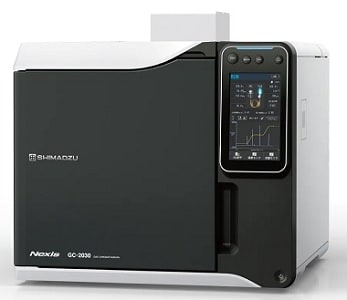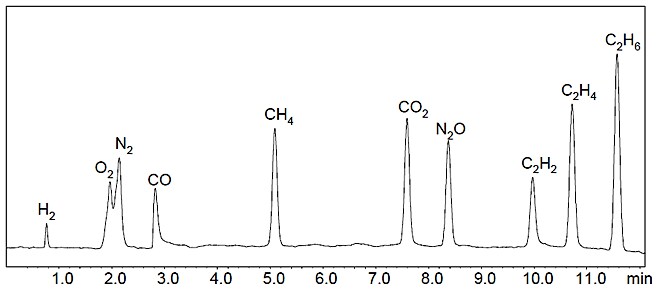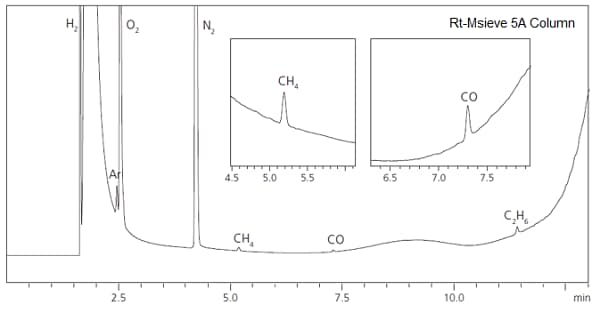High-Sensitivity Analysis System for Inorganic Gases

Gas containing inorganic gases and hydrocarbons is typically analyzed in any number of industries using a gas chromatograph (GC). Generally speaking, either a flame ionization detector (FID) or a thermal conductivity detector (TCD) is selected depending on the type and concentration of the gases being analyzed. However, a gas analysis system equipped with a barrier discharge ionization detector (BID) can analyze almost any component except helium (He) and neon (Ne) with high sensitivity.
The Shimadzu high-sensitivity analysis system for inorganic gases can simultaneously analyze light hydrocarbons and low-concentration inorganic gases, including atmospheric components such as oxygen and nitrogen. It utilizes a gas sampler equipped with a purge mechanism to prevent contamination by air, and a special splitter. Because of its versatility, this system improves laboratory productivity by accommodating a wide range of gas analyses.
Simultaneous Analysis of Inorganic Gases and Light Hydrocarbon Gases
When analyzing the purity and composition of gases, the analysis of concentrations (on the order of several ppm) difficult for a TCD conventionally required a complicated system combining a methanizer and FID, and that is equipped with a pre-cut mechanism. The Shimadzu system can simultaneously analyze inorganic gases and light hydrocarbons using a simple configuration with a suitable column connected to a BID.

Example of the Analysis of Various Gases at 5 ppm Concentration in He
- For details, refer to GC Application News "No. G297 Comparison of Separation by MICROPACKED-ST Columns."
Analysis of Trace Impurities in Pure Gases
If the hydrogen fuel used in fuel cells contains carbon monoxide or other impurities, this will toxify the catalyst used in the cell, reducing the catalytic performance. Accordingly, high-purity hydrogen fuel is required. A high-sensitivity analysis system for inorganic gases based around the Nexis GC-2030 is capable of a dual-line configuration equipped with two BID units. Connecting two different columns enables a wide range of impurities to be quantified with high sensitivity in a single analysis.

O2: Approximately 100 ppm, N2: Approximately 340 ppm, Other Components; Approximately 0.2 ppm

O2: Approximately 25 ppm, N2: Approximately 160 ppm, CO2: 0.44 ppm, Other Components; Approximately 0.2 ppm
Example of the Simultaneous Analysis of Impurities in Hydrogen
News / Events
-
Explore GC Systems for Official Standards
Each Shimadzu System GC Analyzer is meticulously built and rigorously tested to meet the specific analytical needs outlined by applicable industry standards, providing dependable performance for a wide range of applications.
-
Unlock New Possibilities with the Fully Loaded Brevis GC-2050: Expanded Inlets, New Detectors, Lower Costs
Explore how the Shimadzu GC Brevis GC-2050 can help your lab achieve significant cost savings and enhance efficiency.
-
PONAsolution has been released
The PONAsolution is an analytical software for LabSolutions that effectively supports PONA Analysis and Detailed Hydrocarbon Analysis.
-
User's Voice from Nanospace Catalysis Research Unit, Institute of Integrated Research (IIR), Institute of Science Tokyo
From the Development of Zeolite Catalysts to Achieving Carbon Neutrality using Gas Chromatography
-
The Gas Chromatograph Brevis GC-2050
The Gas Chromatograph Brevis GC-2050 has been fully updated -compact, powerful, and cost-efficient- crafted to elevate your productivity to unprecedented levels.
-
COA Search for SH Series GC Columns is now available
A Certificate of Analysis (COA) is a document that ensures the product meets the shipping requirements. COA Search for SH Series GC Columns has been released.


